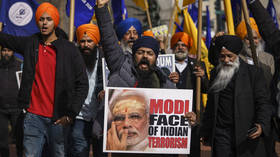No longer POC? Grouping together of Asian and white students by Washington school district sparks accusations of 'racecraft'

Asian kids were excluded from the 'people of color' category in a performance report of a Washington school district, leading to both online mockery and debate about opportunity gaps and race.
The North Thurston Public Schools (NTPS) district highlighted the difference between "students of color" and "white/Asian students" in their equity report on study performance and discipline.
Twitter users spotted this apparent exclusion of Asian American students from the 'people of color' category on Sunday, with some accusing the NTPS of engaging in "racecraft." The NTPS, located in the western part of Washington state, has 22 schools, educating almost 16,000 students.
Asian kids officially kicked out of "students of color" category by a WA school district.https://t.co/HNYsNYBBgppic.twitter.com/UW2tD4Ys8v
— Steven Welliever (@StevenWelliever) November 15, 2020
The district data was meant to not just present academic averages, but also highlight "opportunity gaps for historically underserved students of color," a group to which Asian American kids did not belong, according to the graphs.
Notably, the NTPS had specifically used race as the criteria for dividing kids into the two groups, which did not sit well with some Twitter users.
"Your 'color' is defined by the average performance of your group in school?" journalist Zaid Jilani mockingly pondered on Twitter. The pundit then rationalized that perhaps it was done to avoid "breaking out Asians" into their own group over their statistically high academic performance and thus complicating the issue further.
If they broke out Asians from white students, it would probably necessitate creating endless conversations about Asian privilege or some such thing, it seems like this is the only move they could make to avoid changing the narrative.
— Zaid Jilani (@ZaidJilani) November 16, 2020
At the same time, on their website, the district was still separating white and Asian students, while promoting itself as "the most diverse" school district in the South Sound area.
These findings seemed to greatly humor Asian Twitter users, who started referring to themselves as "white" in order to ridicule the NTPS' approach to race. "We finally assimilated though. Cause to celebrate," quipped one such commenter. "I'm white now y'all," chimed another.
I guess we are "white" now.
— Bijay Acharya (@bijayacharya) November 16, 2020
We finally assimilated though. Cause to celebrate.
— Akash Shetye (@AkashShetye) November 16, 2020
Hello my fellow Whites. https://t.co/SxlYff8HpF
— Ian Miles Cheong (@stillgray) November 16, 2020
I’m white now y’all. Anyone want to go to Gap? https://t.co/Bc1pbWi5cK
— Vishal Ganesan (@vjgtweets) November 16, 2020
However, it also led to a public conversation on race and opportunity gaps.
Asian Americans' median income and education levels statistically surpass those of other people of color and white citizens, thus they are often seen as a disproval of race being a factor that determines one's material conditions.
Asians are too successful and it shatters the Progressive doctrine that only white people can be “oppressive”. So now they’re rebranded... The term “PoC” has little to do with actual skin color; it’s just a way to label people for political, societal, or ideological convenience.
— Coleslaw (@vincentcoled) November 15, 2020
Asian people don't play that racist card. We also don't need a hand out we just study hard because if we don't our parents and our uncles and our mom best friend would kick our ass for getting A- on a test lol.
— WE THE PEOPLE (@WETHEPE50221276) November 16, 2020
One of the most fascinating things about the "wokeness" movement is how it seems eager to erase the identities of several cultures, including immigrant communities, with Asian Americans at the top of the list.
— NYC kids belong in school (@kristinbrooklyn) November 16, 2020
Commenters speculated that perhaps income inequality would have been a more relevant marker of opportunity gaps. "Look how much bigger the poverty to non-poverty gap is," one person tweeted, comparing the various stats in the NTPS graphic.
Also, look how much bigger the poverty to non-poverty gap is...
— Chris Munce (@chrismunce) November 16, 2020
Statistics demonstrating the successful performance of the Asian American community often turns the discourse around 'whiteness' and 'privilege' in American society upside down. Just last month, Asian women in the US made headlines when it was revealed they had begun to earn more on average than white men.
Also on rt.com So much for ‘privilege’! Asian women achieve higher median income than WHITE MEN, blowing identity politics out of waterDespite these statistically noteworthy achievements, Asian Americans still experience racial discrimination at about the same frequency as African Americans, according to the Pew research center. Furthermore, recent reports say that these instances might have become more common amid the Covid-19 pandemic, which started in China.
Think your friends would be interested? Share this story!















